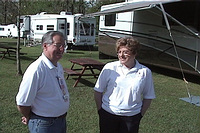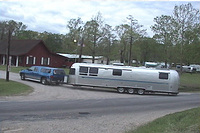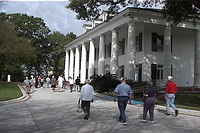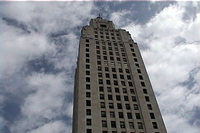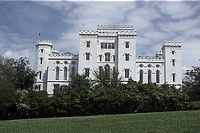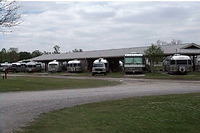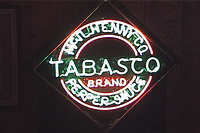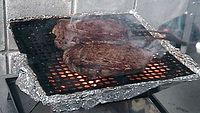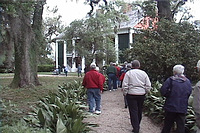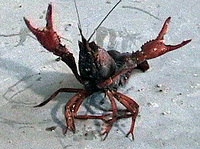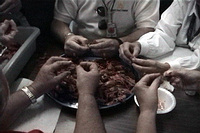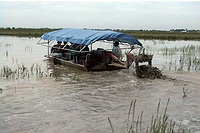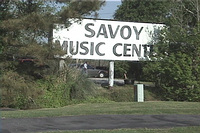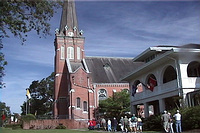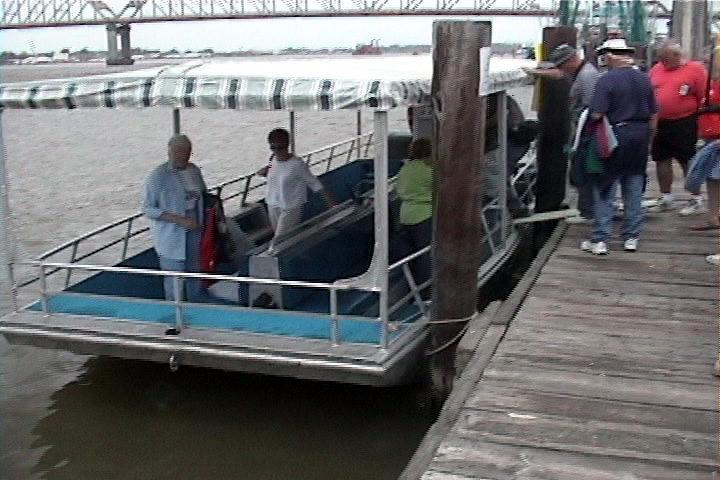After four years on the waiting list for this WBCCI caravan, we were finally on the way. Everyone we had talked to about it told us that we were in for a treat, so we were anxious to see what it was all about.
Monday, March 31, 2003 - Our departure was delayed a bit when I discovered that two deep-cycle Delco Voyager batteries were bad. I replaced them with two Life Line batteries and got underway about 9:45am. The weather was cool, but clear - a few patches of snow left on the ground here and there, left from yesterday's rather heavy snow. We drove south to Atlanta, then southwest on I85 toward Montgomery, Alabama, stopping for the night at Shorter, about 15 miles short of Montgomery, at the Winddrift Campground, a nice modem friendly RV park on a small lake. Think most of the campers were workers as opposed to tourists. We had driven about 265 miles.
Tuesday, April 1, 2003 - We got on the road early this day and made good time through Montgomery and Mobile, Alabama, Gulfport, Mississippi and Baton Rouge, Louisiana. It was another cloud free day with temperatures warming to 75 degrees in mid-afternoon. We crossed the Mississippi River at Baton Rouge and arrived at the Frenchman's Wilderness Campground near Beaux Bridge, Louisiana about 4:00pm. There were some 12 Airstream units already in camp awaiting the caravan rendezvous. We met the caravan leaders, Conrad and Nettie Simoneaux, who were greeting each unit as they arrived. We will be going on the second section of the caravan - the first having completed the route a week ago.
Wednesday, April 2, 2003 - A lazy day. Driving the few extra miles on Tuesday allowed us to take it easy in camp this day, watching the remaining caravan units come in. We took a short drive into the little town of Beaux Bridge. Not much there. Lots of road construction which was sorely needed. We stopped at a Winn-Dixie store to buy a few supplies. While Ann was doing the shopping, I sat and listened with fascination to the people talking. There was no doubt that this was Cajun country. "Cajun" was once a derogatory slur word applied to the French speaking descendants of the immigrants from Acadia - the land we now call Nova Scotia. It's easy to understand how Acadian became Cajun. In the last 50 years, the term has become "cool," and now the people proudly use the term referring to themselves.
All caravanners were in camp by the 3:00pm initial meeting. Caravan manuals were distributed, as Nettie previewed the schedule. We were surprised to see a number of folks that we'd traveled with before - Sid and Sarah Watters (Maple Leaf), Frank and Nora Guros (Florida Fantasy), Jerry and Oleta Flanders (Southwest), and Dave and Carol Keller (Tampa Bay). At 6:00pm the campground provided a catered meal: shrimp and crab gumbo, potato salad, and dessert.
Thursday, April 3, 2003 - A chartered bus came to the campground early for the trip to Baton Rouge. It was nice to ride the 50 miles to Baton Rouge on a comfortable bus. Our first stop was at the Governor's mansion where we had a tour guided by a very knowledgeable young lady. The home was beautifully decorated and furnished, and was located in a nice setting on a lake near the downtown area. Our second stop was at the capitol building - said to be, with its 34 floors, the tallest state capitol building in the United States. The building was one of Huey P. Long's projects in 1935. Inside, we visited both the House of Representatives and the Senate chambers, then rode the elevator to an observation deck on the 27th floor. From there, the view of the Mississippi River, up and down river, was outstanding. To the north was a view of the huge Exxon refinery. Some of the oak and magnolia trees on the capitol site were huge with limbs touching the ground. We found the replica of the liberty bell in a small park a block away from the capitol building. Every state capitol has one of these.
After lunch at an unusual restaurant called The Pastime, we again boarded our bus for the short trip to a historic plantation called Magnolia Mound Plantation. There, a young lady dressed in period clothing, guided us through the plantation house describing life back in the late 18th century with the French family who owned the complex. In the outdoor kitchen all sorts of things grown on the property were being cooked and prepared over the open fire in the fireplace. Among other interesting things inside the house was a quilt made from both white and brown cotton sewn in interesting patterns. The house was about 500 yards east of the river, and was surrounded by huge old oak trees. Those trees could tell some tales if they could talk.
Baton Rouge is on the east bank of the Mississippi River. That city and the rest of today's state of Louisiana east of the river were not part of French controlled territory, but were a part of Spanish East Florida in the 18th century. Neither was this area a part of the Louisiana Purchase. Despite Spanish control, many of the settlers were French like those who owned and operated Magnolia Mound Plantation.
Back at the campground we had our first "GAM," called by our leaders a "Crawfish Clutch." These small group gatherings are designed to allow folks to get to know each other better. Our gathering was at the Andrezejewski's trailer - Dave and Linda. They will be leading the Alyeska caravan in 2004. Others at the Clutch were the Baileys - John and Lavon, the Coxes - Rod and Joanne, and the Demlongs - Art and Lois.
At 6:00pm we carpooled to Pat's Restaurant in the nearby town of Henderson - a restaurant specializing in area seafood. No matter what's ordered, it's spicy hot. We had a platter of fried shrimp that almost caused steam to rise from our ears. There weren't too many other people at the restaurant while we were there, but on the weekends they must really have crowds. One dining room had space for 800 people - a popular place.
Friday, April 4, 2003 - The chartered bus came to the campground again on this morning to take us back to Baton Rouge for another day's touring of the capitol. Our first stop was at a breakfast restaurant called the Coffee Call for beignets and café au lait (ben-yeas' and caufea-olay). Then we moved back downtown to the old state capitol building. This is now a museum of Louisiana memorabilia. The building, completed in 1850, resembles a castle with turrets on its four corners. Despite busloads of school kids we managed to see all the interesting things. Marking the 200th anniversary of the Louisiana Purchase, the original documents evidencing the purchase were on display. Many of the stories of Huey P. Long's political shenanigans were displayed, including the story of his assassination in 1935.
Following the state house tour the bus took us to the Mall of Louisiana for lunch and shopping. We were given multiple coupons to encourage shopping. We only used the one which provided a bargain for a Chic-Filet lunch.
The afternoon activity was a tour of LSU's Rural Life Museum. This 450 acre site inside the city is still largely undeveloped. Old buildings - school, church, barns, overseer house, slave cabins, grist mill, blacksmith shop, and many houses - have been moved in to depict life in the old days. In the museum is an extensive collection of old tools, furniture, farm implements, and vehicles. LSU maintains agricultural experimental projects on the property making it a working plantation.
At 5:00pm we had our second "crawfish clutch" - this time with five other couples: Harold and Doris Osborn, Ralph and Zoe Forrester, Harold and Libby Hull, Walt and Marie Seagrave, and the Watters - Sid and Sarah.
At 7:30pm we gathered again for a drivers meeting for the next day's move to Morgan City. The procedure was a little different than usual. The caravan was divided into seven groups, each with a different color code. Each group of four units were set to travel together, leaving at 15 minute intervals. We were with the yellow group to leave at 9:45am in the morning. The first group to arrive in Morgan City will serve as parkers for the rest of the day.
Following the meeting, we played a couple of games of Joker with the Seagraves, Walter and Marie. The men were victors.
Saturday, April 5, 2003 - The 110 mile trip, as we moved down to Morgan City, was uneventful. The roads were pretty rough. We passed sugar cane fields just recently harvested and what looked like small oil refineries. The most notable sight was the underground oil reservoirs where the nation's oil reserves are held. Oddly the area surrounding the reservoir site is all swamp. Our campground is on the shore of a large and beautiful lake that appears to be a playground area for local people. The lake is in the Atchafalaya River basin.
In the afternoon we drove around the lake to a point where a carillon tower has been built in the cypress swamp. This was the Brownell Memorial Park. The set of 61 bells atop the 106 foot tower were cast in Holland and are electronically driven. The largest bell weighs 4,732 pounds. A caretaker told us the story of how the bells were given to the community by the Brownell family.. Following this we went back to camp for a Saturday afternoon church service conducted by one of the caravanners - Cecil Hardy. Several of the group went into Morgan City for a Catholic service at the same time. Following that we went with the Watters into Morgan City to a Ryan Steak House for supper.
Sunday, April 6, 2003 - There were several heavy showers during the night, and the temperature has gone up. It was quite warm - in the 80s. The skies were overcast as we emerged from our aluminum cocoon. We were again divided into groups. Our group went first to the "Rig" Museum. This was the original floating oil drilling rig, now imbedded at a spot on the Morgan City waterfront. Called "Mr. Charlie," it was first put in service in the Gulf of Mexico in 1954. Prior to this, off shore drilling rigs had to be built on site, then dismantled before being taken to and re-erected at the new site. With "Mr. Charlie" the rig was towed to the drill site and submersed to sit on the bottom. When the drilling was complete, they refloated the rig and towed it to the next site. The rig was self contained, housing up to 58 crew members who worked 12 hours on, 12 hours off for seven day stints. In addition to being a museum, it is now also used for a training facility. We climbed all over the rig and got an excellent description from our guide of the way the drilling operation worked. Once the drilling operation was over, the drilling rig is re-floated and moved away so that the pumping rig could be moved to the well. Newer drilling rigs are much larger, but the principle is the same. Our guide mentioned the Hibernia project which we saw in Newfoundland, saying that it was the largest in the world.
Then we boarded a boat for a twenty mile trip back into the bayou. The Atchafalaya Swamp with its million plus acres of swamp is the largest swamp in North America. On the way in we spotted a bald eagle high in a cypress tree. There was not much other wildlife visible, but it was clearly an area where aquatic life could flourish. According to our guide - Cajun Jack - there are 52 Cajun families still living in the swamp - this compared with some 800 families that lived there just fifty years ago. Those still there make their living hunting and fishing and catching crawfish. We stopped at one floating house where folks were eating their noon meal. They shared some fried fish with us. The wind picked up as we made the return trip to Morgan City. The lake kicked up, and most of us got pretty wet. Cajun Jack said that in 17 years of making that trip, it was the first time he'd ever seen the water that rough.
At the 7:30pm drivers meeting we got instructions on the 70 mile trip to St. Martinville the next day.
Monday, April 7, 2003 - We were the second group leaving this morning at 8:45am. We again crossed the high bridge over the Atchafalaya River, passed the Super Wal-mart, and took SR182 north - our destination: Catfish Heaven Campground at St. Martinville. The closer we got to St. Martinville, the further deterioration in the weather - rain, thunder and lightning. Passing through the town of Franklin, we saw a number of beautiful antebellum homes fringed by huge live oaks.
St. Martinville is the center of Acadian culture - the "Birthplace of Acadiana." It is also known as the home of Evangeline, the young Acadian woman immortalized in the famous poem by Henry Wadsworth Longfellow. There are many memorials to the 1765 arrival of the Acadians in Louisiana.
The Acadian exile from what is now Nova Scotia was brutal. Wives and husbands were separated as were young lovers. So it was with Evangeline and Gabriel. They were separated when the women were loaded on one ship and the men on another. For three years Evangeline sought the man she loved. When she arrived in Louisiana, she boarded a small boat to come up Bayou Teche, landing at the present site of St. Martinville - near an ancient oak tree on the banks of the bayou. It was there she spotted Gabriel. Running up to him excitedly, she threw her arms around him, only to have him tell her that he had married someone else. Evangeline was heartbroken. Tradition has it that she died in St.Martinville and is buried in the Catholic cemetery near the church. The real names of Evangeline and Gabriel were Emmeline Labiche and Louis Arceneaux. The story typifies what happened to many of the Acadians.
The Louisiana territory was under Spanish control when the Acadians came. Part of their reason for coming was the offer of land. Each family was given a Spanish land grant. It was later that the French took control. In 1803, when Thomas Jefferson sent emissaries to Paris to try to buy New Orleans, they were surprised to have Napoleon tell them that if they wanted New Orleans, they had to take the whole Louisiana territory - and they had to pay $15,000,000 for it. It, of course, turned out to be a bargain, but at the time, it almost bankrupted the young country.
Despite the rain, we drove into town the afternoon we arrived, to visit the Acadian Culture Center, the Evangeline Oak, the eternal flame honoring the exiles, the Acadian Memorial, the St.Martin de Tours Catholic Church, and the Le Petit Paris Museum. Our Cajun guide was excellent in her description of things. Because of their refusal to deny their Catholic faith and pledge allegiance to the English king, 10,000 people were herded aboard English ships in 1755 to be dispersed around the world. 3,000 of them made their way to Louisiana some ten years later, almost all of whom have been documented and memorialized on the Wall of Names in the Acadian Memorial. Mardi Gras costumes on display at the Le Petit Paris Museum were extraordinary. We dodged showers all afternoon, managing to see all of this without getting too wet. The rain kept the musicians away who normally play Cajun music at the foot of the Evangeline Oak. 

The campground at St. Martinville is most unusual. There is a large pavilion - a covered picnic area - with concrete campsites angled around it. Our Airstreams were backed right up to the pavilion. Our "crawfish clutch" meetings at 5:00pm were held in the pavilion - in the rain, with lightning flashing all around. It was far too loud to hear anyone talk.
Tuesday, April 8, 2003 - It rained hard off and on all night, and was still raining at daybreak. Conrad told us about a bird rookery a few miles from the campground. It was misting rain, but we ventured over there to see. Thousands of snowy white egrets and pink spoonbills were nesting in the cypress trees. Some had young in the nests and were feeding them. A number of nutria (brown rodents) were in clumps of bushes in the water. The area was said to be full of alligators, but we saw only one. The birds were incredible to watch, somewhat remindful of the gannets we saw in Newfoundland.
The activity of the afternoon was to carpool to Avery Island, a remarkable place. Avery Island is a large mound or hill in an otherwise flat landscape. It was discovered 150 years ago that the mound covered an enormous deposit of salt - a deposit thought to extend downward at least as deep as Mt. Everest is high. It was first exploited by the Avery family, thus the name. The Averys were forced out by Union troops during the Civil War, but reclaimed the land afterwards and continue to mine both the salt and oil that has also been found under the mound.
The "island" is also the home of McIlhenny Tabasco Sauce. Edmund McIlhenny married into the Avery family, then planted a few red pepper plants and developed his famous tobasco sauce. This pepper sauce is made from capsicum peppers, first grown on Avery Island shortly after the Civil War. Newly harvested peppers are mashed at the factory and aged for three years in white oak barrels. The aged mash is then mixed with special vinegar and stirred for a month before the mixture is poured into the familiar slim bottles and shipped all over the world. We toured the plant and were given some samples. They were producing at the rate of 580,000 bottles per day.
Avery Island is also an egret and wildlife sanctuary and gardens. Called The Jungle Gardens, the "island" is covered with massive live oaks and many other tropical plants. The limbs of the oak trees were covered with green resurrection fern, reflecting the rains of the last few days. There were swamp areas with alligators and nutria. There was an area that had been turned into a rookery for American and snowy egrets. A guide in the lead car led us through the gardens on a narrow gravel road, describing what we were seeing in her Cajun brogue.
Back at camp that evening, we had a steak cookout. All who had barbecue grills gathered under the pavilion for a delicious steak cookout - the steaks provided by our leaders. Following the meal, a local sugarcane expert described the process of farming and milling sugar. Of the three states that produce sugarcane - Texas, Florida, and Louisiana - Florida has the most production, but Louisiana has the most sugarcane acreage. We learned that the cane is a perennial plant. One planting is good for four years of harvest. Sugarcane farming is obviously a major part of the economy of the state. It was an interesting seminar with lots of well answered questions from the caravanners.
Wednesday, April 9, 2003 - Sunshine!! It was on the cool side, but a beautiful day to visit an antebellum home in New Iberia called Shadows of the Teche. The home on the banks of Bayou Teche was built in 1834 by a wealthy sugar planter, David Weeks. His sugar plantation was several miles away at a place called Weeks Island. Four generations of the Weeks family lived at the "Shadows," the last being Mr.Weeks Hall who gave the property to a national trust in 1959. It is now a museum of life in Louisiana the way it was 170 years ago.
We rode over to New Iberia with Harold and Libby Hull. On the way back we stopped at the Longfellow Evangeline State Historic Site. Beside the monument to Longfellow, there was a Creole cottage on display that was built in 1815 by the French Creole Charles DuClozel Olivier. Creoles are descendants of Europeans who came directly to Louisiana in the 17th century, some mixed with African-Americans.
In the evening we carpooled to Breaux Bridge and the Mulate's Restaurant for a seafood dinner to the tune of a Cajun band. Riding with us were Jerry and Oleta Flanders and Harold and Libby Hull. This restaurant has been in the area for many years with a great reputation. A plaque out front honored the restaurant as making a significant contribution to the promotion of Cajun culture. The crowds were orderly, but lively. Many of our caravanners were enjoying themselves on the dance floor.
Thursday, April 10, 2003 - Moving day again - this time to the Civic Center in Rayne. It was a clear day, but cold. The thermometer read 38 degrees at daybreak, and there was frost all around. The trip to Rayne was a short one - just 30 miles. We parked on grass across from the civic center and a baseball park.
Rayne is known as the frog capitol of the country. They have an annual frog festival. Frogs are painted on signs all over town. But there are no live frogs. The town's reputation dates back to an earlier time when frogs were prevalent and commercially harvested. We began the afternoon with a visit to City Hall and a welcome by the mayor - Jim Pettitjean. An outgoing, friendly man, the mayor held us spellbound for a half hour talking about his town. Rayne is where Conrad and Nettie have their home.
Later we went out to a rice and crawfish farm - the Crystal Rice Plantation. After harvesting a rice crop, they flood the fields and grow crawfish. The founder of this farm was Salmon Lusk Wright, a Yankee farmer who came to Louisiana in 1890 to grow rice. He was a leader in his field, developing many superior grades of rice, the best being a variety he called Blue Rose. Due to above normal rainfall this year, there is a bumper crop of crawfish. These strange looking little animals, burrow themselves in the ground underneath the rice, then come out in huge quantities when the fields are flooded after the rice harvest. The crawfish look like small lobsters - five or six inches long. They are all sold fresh, packed alive in 40 pound sacks. The rice is harvested, but not processed on the farm. It is shipped to mills nearby for processing. The farmers cooked up 40 pounds for us to sample. Also on the property are two museums - one of china and crystal ware in a house, and a number of old cars in a warehouse behind.
Friday, April 11, 2003 - We started the day with a tour of a rice mill - Stancel Rice Company. This small mill specializes in a gourmet popcorn rice. They start with a special strain of rice and run it through a four-stage scrubbing and screening process to produce special quality rice products. 60 peacocks, freely roaming the grounds, eliminate any mice that might otherwise be a problem with the grain. Outside, airplanes were spreading seed in a newly prepared field. They first drain the field, then spread seed, then flood the field when the new plants emerge. All the while crawfish have burrowed deep into the mud, and after the rice is harvested, it's time to gather the crawfish (or mudbugs, as the locals affectionately refer to them).
Our leaders surprised us by taking us to a rally of the local WBCCI unit for lunch - the Louisiana Acadiana Unit. One of the unit members had cooked up a huge batch of crawfish fettuccinne. Each unit member "adopted" a caravanner to sit with for the meal. We wound up with Elmore and Lynn Bonin, president of the unit.
The afternoon activity was a ride in a crawfish boat while the driver was working the traps. These boats are unusual. Propelled by a hydraulic paddlewheel extended on a long arm on the stern, they are designed to navigate around a muddy field under six inches of water. There are two wheels on the front of the boat keep the front end from dipping below the surface. We were taken out six at a time. The driver picks up the traps, dumps the crawfish (2 or 3 dozen) on a table, rebaits the trap, and moves on. He steers the boat with his feet, swinging the paddlewheel arm back and forth to maneuver. The boat moves from one field to another by simply driving up and over the dividing levee. It was a unique experience.
At the drivers meeting, we received instructions for the next move on Sunday, then had an ice cream social. We again played Joker with the Seagraves, introducing them to the split-nine variation.
Saturday, April 12, 2003 - Cajun music is a major part of their culture. It usually involves the use of an accordion. This was the day we concentrated on Cajun music. A chartered bus came to the campground this morning to take us to Savoy's French Accordion Maker and Music Jam in Eunice, Louisiana. Eunice is about 40 miles due north of Rayne and calls itself Louisiana's Prairie Cajun Capitol. There's an Acadian culture center, the Cajun Music Hall of Fame, the Liberty Center for Performing Arts, and a museum of Cajun history. At Savoy's we watched Marc Savoy demonstrate the making of an accordion and relate the instrument's history. The Cajuns didn't bring the accordion with them from Canada. It was introduced to the culture in the early 19th century by German immigrants to the area. But the Cajuns have adopted it wholeheartedly and have created with it a unique style of music. Marc Savoy sells his accordions for about $1200. Every Saturday morning at Savoy's they have a jam session in which anyone with a musical instrument can join in. At one point while we were there 21 musicians were playing. All were playing by ear, and it sounded good. This was one of those unique things that one would never come across without a caravan.
The bus then took us to the town of Mamou ten miles to the north. There, again at a Saturday morning event, we visited Fred's Lounge which was crowded with people playing and listening to Cajun music. It was a boisterous throng of people. A local radio program was being broadcast from the lounge - in French. Between commercials, the music was being broadcast as a radio show. The owner of the lounge is the widow of Fred. She sings with the band and circulates among the crowd passing out little pieces of sausage called "boudin." She keeps the tavern open only on Saturday for this activity.
Back in Eunice we visited the Prairie Cajun Culture Center, a National Historical Park and Preserve. After a few minutes of looking at the exhibits, we gathered in an auditorium for another Cajun music demonstration. Four musicians, including one of the rangers, played the cultural music for an hour. Many caravanners found their feet dancing to the spirited beat. We then tasted a Cajun syrup cake made by an elderly Cajun woman who was also a standup comic.
Lunch had been arranged for the group at a Eunice restaurant - Nick's. Afterward we had a couple of hours free to roam the streets. There was a group of 320 bicyclers in town on a 200 mile, 4 day trip through the prairie Cajun countryside. At 6:00pm we went to the Liberty Center for the Performing Arts for yet another Cajun and Zydeco musical show. We couldn't understand the emcee's French, but the enthusiasm shown by these people for their music was impressive. After a full day, we arrived back at our campsite in Rayne about 8:10pm.
Sunday, April 13, 2003 - This was a lazy day after a busy one. We attended an in-house church service conducted by Cecil Hardy at 9:00pm. It was short and sweet with prayers of thanks for the seven missing American soldiers that were found this morning. Then, it was a three hour wait until time to leave for our next and last stop at Bayou Wilderness RV Resort in Carencro, Louisiana - only 35 miles away. It was an easy trip in beautiful warm weather. We were scheduled to be parkers, but there was nothing to do as the long pull-through sites with full hook-ups were no problem for everybody to find and park on their own. The weather turned very warm - 83 degrees.
In mid afternoon we gathered at the rec hall for a scavenger hunt. The caravanners were divided into groups of three couples each, then each group was given a list of about thirty items to gather. The group getting the most items in the least amount of time was the winner. The hooker on the list was and x-ray. How many people carry x-rays in their RV? But I did, x-rays taken of my back about five years ago. Luckily, I remembered them. So we won the competition - the Bergs, Walter and Ann, the Andrezejewskis, Dave and Linda, and the Baileys, John and Lavon. Later, our leaders had pizza brought in for a feast, and a good time was had by all.
Monday, April 14, 2003 - The chartered bus was back again on this foggy morning, this time to take us to Abbeville, the seat of government for Vermilion Parish - about 15 miles south of Lafayette. Our first stop was at the Mayor's office at the City Hall. They were ready for us with a full breakfast, spread in the council room - rice and scrambled eggs, biscuits, biegnets, melon balls, pure cane syrup and orange juice. It was an unusual greeting and welcome to the little city. Ladies in red, white, and blue costumes were ready to take us on a walking tour of the downtown area. We visited their church - the St. Mary Magdalen Catholic Church - the old cemetery, the town square with huge old oak trees, the Vermilion Parish Courthouse, and the Old Depot, now a gift shop. We were then free to roam the streets and shops for an hour before lunch at "Shucks."
The citizens of Abbeville have taken unusual pride in their city and work hard to keep it clean and attractive. An annual event in Abbeville is the November cookout in front of the Courthouse during which a huge omelet is prepared using 5,000 eggs in a large skillet where boat paddles are used as stirrers. When the omelet is done, it is served free to anyone in attendance.
The restaurant called Shucks is a seafood restaurant specializing in oysters, being shucked fresh behind picture windows. We put a dent in their oyster supply, though some had shrimp and others catfish. It was an excellent meal.
Following lunch the bus took us to a reconstructed replica of an 1800 Cajun village. All the buildings were authentic, having been moved in from other areas. The houses were gathered on the banks of a bayou. We gathered first in the church where a Cajun lady described what was there to see, then roamed the village at will. Geese wandered around the village, and the bayou was teeming with fish and turtles. We were home again at the campground by 5:30pm, after another full day.
Tuesday, April 15, 2003 - After a continental breakfast of coffee and doughnuts at the campground rec hall, we carpooled in to Lafayette to the St. Johns Cathedral. The tour of the cathedral and grounds was conducted by an extremely knowledgeable lady who dramatically described everything is minute detail. The tour began at the Cathedral Oak outside, a gigantic oak tree some 26.7 feet in circumference, a dimension consistent even up 10 feet or more from the ground. The tree was 8.5 feet in diameter and had a limb span of over 80 feet. The huge limbs, covered with resurrection fern, had to be support by screwjack braces in several places. It was estimated that the acorn from which the tree grew was planted not long after Columbus discovered America.
The tour then moved to the cathedral itself. The Cajun people brought their Catholicism with them from Nova Scotia and remain steadfast in that faith. Our guide took us from stained glass window to stained glass window describing the scriptural event being depicted. The windows told the story of Jesus from nativity through his miracles to his crucifixion and resurrection. Our guide missed very little in her dramatic description of church details.
One thing learned was the fact that the Vatican State was created February 11, 1929 by the "Lateran Treaty," an agreement entered between Pope Pius XI and his representative, Cardinal Gasparri, on the one side and Italian King Victor Emanuel and his representative, Benito Mussolini, on the other.
On Tuesday evening we gathered at Don's Restaurant in Lafayette for our final banquet. After an excellent meal, each caravanner gave his and her impressions of the caravan. There were both serious and humorous remarks, but the consensus was that everyone now had a better idea of what this part of the country and what Cajuns were all about. As is always the case at the end of a caravan, there were nostalgic moments when saying good-bye.
Wednesday, April 16, 2003 - The long, two day drive home began about 9:00am as we headed east along I-10 through Baton Rouge, Gulfport, Mobile, Montgomery, and Atlanta to Young Harris.
Wrap-up
The trip through Cajun Louisiana met all the usual caravan elements of fun, fellowship, and adventure. It also gave the caravanners a good look at Cajun culture. We experienced Cajun food, Cajun music, their Catholic religion, and their fun loving nature. We heard about their history - their deportation from Nova Scotia and arrival in Louisiana. We saw how they lived, both in the bayous and on the prairie. We learned about their economy - from oil, rice, sugarcane, seafood, cattle, and crawfish. All this added together made for a pleasure packed, though busy two weeks. It had been well worth the long wait. The leaders, Conrad and Nettie Simoneaux, did a masterful job of planning, coordinating, and conducting the caravan.
